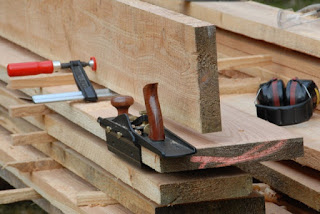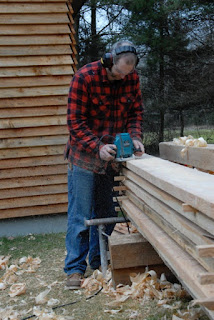She thought that it would be fun too, so we started discussing what we should build.
I suggested building a passive speaker for her Iphone, and she was a bit curious about what that was. After showing her some made out of wood we tried to search Youtube to see if there were other passive speakers - and get some more inspiration.
One speaker was made out of an old hunting horn, and it looked kind of cool. It would also go perfect with the bookcases due to all the brass hardware on those.
Luckily for Laura, I had once bought a hunting horn in Poland, back in 1988 - so that model was within reach.
We immediately headed into the shop and found a piece of elm and got going.
Laura took some photos during the build, so all the photos are courtesy of her.
The idea of a passive speaker is to make some sort of channel that the sound can travel through, and then end out in something that will amplify the sound. In our case the bell mouth of an old hunting horn.
I started by squaring up a thick piece of massive elm, and then split it horizontally.
A long slot was made using the mortising machine, and a through hole was made at the exact location of the speaker on the phone itself.
A large hole was drilled in the centre of the top board, and on the underside of this board, the large hole and the small speaker hole were connected with a channel, I think it was approx. 5/16" deep.
The two boards were then glued back together and while the glue dried we started working on the brass part.
Since the horn was soft soldered together, it took only a little heating with a propane torch to loosen the joint. After separating the bell mouth from the rest of the horn, I used a pipe cutter to cut of a length of the curved pipe that we would also use.
The curved piece was soldered back on in a 180 degrees twisted position, so the horn would end flowing in a bit of an S shape.
Some sort of disc or flared part was needed to be able to mount the brass part onto the wooden base.
I did't have any sheet brass lying around, and I thought about firing up the metal lathe and turn something. But I wanted to check if I had something stashed away first.
After a bit of searching, I found an old candle stand that I think was part of a mystery box I bought at an auction at some point. There were two holders for candles on it, and each one of them had a round "catch the molten paraffin before it reaches the table" thing. (I am sorry, but I don't know the correct English term for this part of a candle holder).
These drip catchers had some Art Nouveau ornamentation on the underside. And since we were going to solder them to the horn part upside down, this ornamentation would be visible once the speaker was done.
We drilled holes for three mounting screws and countersunk those. The centre hole was enlarged so the brass tube could slip on, and then I soldered it together.
The parts were washed and I lightly brushed the ornamented part with a brass brush to clean it up a bit.
Then we screwed the horn part onto the elm base and we were ready for the first test of the speaker.
I found some of the green felt that was left over from the travelling bookcase project, and it was glued to the underside of the base. Next morning when the glue had dried, I trimmed the surplus felt so it looked nice.
All in all this was a fairly quick project. I think it took a little less than 3 hours in total, including a bit of tea drinking during the process and searching for parts etc.
The sound quality isn't overly impressive, if you are testing it out on modern music. But for classical pieces such as "We'll meet again" with Vera Lynn, it is downright great.
Making projects with children is always high up on my favourite list, because they build memories as well as objects.
Steam punk passive speaker.
Firing up the band saw and looking if the small piece of string will hold the window from falling down.
The split base (and an auger that we didn't use)
Soldering on the flared bottom.
Testing.






















